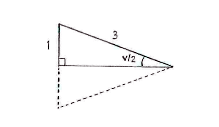Solution 4.2:2f
From Förberedande kurs i matematik 1
(Difference between revisions)
(Ny sida: {{NAVCONTENT_START}} <center> Bild:4_2_2f.gif </center> {{NAVCONTENT_STOP}}) |
m |
||
| (4 intermediate revisions not shown.) | |||
| Line 1: | Line 1: | ||
| - | + | Because the triangle is isosceles (two sides have the same length), it can be divided up into two right-angled triangles of the same size by introducing a side which divides the angle ''v'' in half. | |
| - | + | ||
| - | {{ | + | [[Image:4_2_2_f.gif|center]] |
| + | |||
| + | If we look at one of the triangles, we can set up the trigonometrical relation | ||
| + | |||
| + | {{Displayed math||<math>\sin\frac{v}{2} = \frac{1}{3}\,,</math>}} | ||
| + | |||
| + | which is an equation for ''v''. | ||
Current revision
Because the triangle is isosceles (two sides have the same length), it can be divided up into two right-angled triangles of the same size by introducing a side which divides the angle v in half.
If we look at one of the triangles, we can set up the trigonometrical relation
| \displaystyle \sin\frac{v}{2} = \frac{1}{3}\,, |
which is an equation for v.

